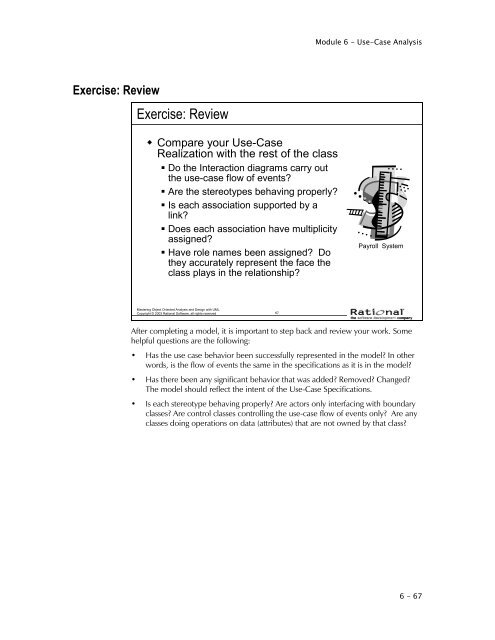DEV475 Mastering Object-Oriented Analysis and Design with UML ...
DEV475 Mastering Object-Oriented Analysis and Design with UML ... DEV475 Mastering Object-Oriented Analysis and Design with UML ...
DEV475 Mastering Object-Oriented Analysis and Design with UMLExercise: Use-Case Analysis (cont.)Exercise: Use-Case Analysis (cont.)• Produce the following for aparticular use case:• Use-Case Realization Interactiondiagram for at least one of the usecaseflows of events• VOPC class diagram, containingthe analysis classes, theirstereotypes, responsibilities,attributes, and relationships• Analysis class to analysismechanism mapMastering Object Oriented Analysis and Design with UMLCopyright © 2003 Rational Software, all rights reserved 66Start with diagramming the basic flow and then do the other sub-flows if you havetime.The Interaction diagrams may be collaboration or Sequence diagrams. On anInteraction diagram, sending a message to an object means that you are allocatingresponsibility for performing that task to the object.Be sure to use the “//” naming convention for responsibilities.Refer to the following slides if needed:• Review: What is a Use-Case Realization? – p. 6-10• Example: Sequence Diagram – p. 6-31• Example: Collaboration Diagram – p. 6-33• Example: VOPC Finding Relationship – p. 6-526 - 66
Module 6 - Use-Case AnalysisExercise: ReviewExercise: Review• Compare your Use-CaseRealization with the rest of the class• Do the Interaction diagrams carry outthe use-case flow of events?• Are the stereotypes behaving properly?• Is each association supported by alink?• Does each association have multiplicityassigned?• Have role names been assigned? Dothey accurately represent the face theclass plays in the relationship?Payroll SystemMastering Object Oriented Analysis and Design with UMLCopyright © 2003 Rational Software, all rights reserved 67After completing a model, it is important to step back and review your work. Somehelpful questions are the following:• Has the use case behavior been successfully represented in the model? In otherwords, is the flow of events the same in the specifications as it is in the model?• Has there been any significant behavior that was added? Removed? Changed?The model should reflect the intent of the Use-Case Specifications.• Is each stereotype behaving properly? Are actors only interfacing with boundaryclasses? Are control classes controlling the use-case flow of events only? Are anyclasses doing operations on data (attributes) that are not owned by that class?6 - 67
- Page 224 and 225: DEV475 Mastering Object-Oriented An
- Page 226 and 227: DEV475 Mastering Object-Oriented An
- Page 228 and 229: DEV475 Mastering Object-Oriented An
- Page 230 and 231: DEV475 Mastering Object-Oriented An
- Page 232 and 233: DEV475 Mastering Object-Oriented An
- Page 234 and 235: DEV475 Mastering Object-Oriented An
- Page 236 and 237: DEV475 Mastering Object-Oriented An
- Page 238 and 239: DEV475 Mastering Object-Oriented An
- Page 240 and 241: DEV475 Mastering Object-Oriented An
- Page 242 and 243: DEV475 Mastering Object-Oriented An
- Page 244 and 245: DEV475 Mastering Object-Oriented An
- Page 246 and 247: DEV475 Mastering Object-Oriented An
- Page 248 and 249: DEV475 Mastering Object-Oriented An
- Page 250 and 251: DEV475 Mastering Object-Oriented An
- Page 252 and 253: DEV475 Mastering Object-Oriented An
- Page 254 and 255: DEV475 Mastering Object-Oriented An
- Page 256 and 257: DEV475 Mastering Object-Oriented An
- Page 258 and 259: DEV475 Mastering Object-Oriented An
- Page 260 and 261: DEV475 Mastering Object-Oriented An
- Page 262 and 263: DEV475 Mastering Object-Oriented An
- Page 264 and 265: DEV475 Mastering Object-Oriented An
- Page 266 and 267: DEV475 Mastering Object-Oriented An
- Page 268 and 269: DEV475 Mastering Object-Oriented An
- Page 270 and 271: DEV475 Mastering Object-Oriented An
- Page 272 and 273: DEV475 Mastering Object-Oriented An
- Page 276: DEV475 Mastering Object-Oriented An
Module 6 - Use-Case <strong>Analysis</strong>Exercise: ReviewExercise: Review• Compare your Use-CaseRealization <strong>with</strong> the rest of the class• Do the Interaction diagrams carry outthe use-case flow of events?• Are the stereotypes behaving properly?• Is each association supported by alink?• Does each association have multiplicityassigned?• Have role names been assigned? Dothey accurately represent the face theclass plays in the relationship?Payroll System<strong>Mastering</strong> <strong>Object</strong> <strong>Oriented</strong> <strong>Analysis</strong> <strong>and</strong> <strong>Design</strong> <strong>with</strong> <strong>UML</strong>Copyright © 2003 Rational Software, all rights reserved 67After completing a model, it is important to step back <strong>and</strong> review your work. Somehelpful questions are the following:• Has the use case behavior been successfully represented in the model? In otherwords, is the flow of events the same in the specifications as it is in the model?• Has there been any significant behavior that was added? Removed? Changed?The model should reflect the intent of the Use-Case Specifications.• Is each stereotype behaving properly? Are actors only interfacing <strong>with</strong> boundaryclasses? Are control classes controlling the use-case flow of events only? Are anyclasses doing operations on data (attributes) that are not owned by that class?6 - 67



